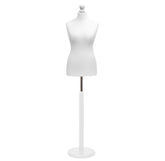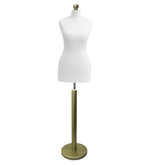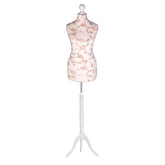Find Your Perfect Portable Clothing Rack Today
Finding Your Perfect Portable Clothing Rack Match
Before you even start browsing, let’s get real: your perfect portable clothing rack is defined by your life, not by a glossy product photo. The ideal rack for a fashion student in a tiny studio flat is completely different from what a pop-up boutique owner needs for a weekend market. Making the wrong choice isn't just an inconvenience; it can be a wobbly, frustrating waste of money. I once advised a client who bought a beautiful, minimalist rack that promptly collapsed under his winter coat collection—a classic case of style over substance. To avoid this, you need to honestly look at your real-world needs.
Assess Your Space and Wardrobe
First things first, get out the measuring tape and figure out the physical footprint you can actually dedicate to the rack. Don’t just measure the floor space; consider the vertical height, especially if you have long dresses or coats that need to hang freely. Ask yourself: will it live permanently in a corner, or does it need to be moved daily? If it’s the latter, lightweight construction and smooth-gliding wheels become non-negotiable features, not just nice-to-haves.
Next, it's time for a ruthless audit of what you plan to hang on it. A few silk blouses and summer dresses have vastly different weight requirements than a collection of ten heavy wool coats and denim jackets. A common mistake is underestimating the combined weight of your garments. A good rule of thumb is to gather everything you intend to hang, weigh the pile on a bathroom scale, and then add at least 20-30% to that number. This gives you the minimum weight capacity you should be looking for and creates a buffer for future purchases, preventing that dreaded rail sag.
Define Your Primary Use Case
How you plan to use your rack will dictate which features truly matter. Are you a home sewing enthusiast creating a capsule wardrobe? You’ll probably value stability and easy access over extreme portability. Or perhaps you're setting up for a retail display, where aesthetics and durability are absolutely key. If you're creating professional displays, you might want to check out our complete guide on using a mannequin with a stand to create a more cohesive look.
This focus on household use is a significant trend, particularly here in the UK. With over 83% of the population living in urban areas, space-saving furniture is in high demand. It’s no surprise that household applications account for over 70% of the clothing rack market, as people in cities like London and Manchester seek practical storage for smaller homes. You can explore more about the UK's storage solution trends on Market Report Analytics. Understanding your specific situation—be it for a small flat or a growing business—is the most critical step in finding a portable clothing rack that will serve you well for years to come.
Decoding Materials That Actually Last
When you're on the hunt for a portable clothing rack, it’s tempting to be swayed by a sleek design or a bargain price. But if you want a rack that won't give up on you, the secret is in the materials it's made from. A cheap plastic rack might seem like a great deal at first, but anyone in retail can tell you it often becomes a wobbly, unreliable liability within months, forcing you to buy a replacement sooner than you think.
Let's get into what really makes a rack stand up to the demands of daily use, whether at home or in a professional setting.
Steel vs. Aluminium: The Great Debate
For sheer strength and durability, steel is the undisputed champion. But it's important to know that not all steel is created equal. You should look for racks made from industrial-grade or commercial-grade steel, preferably with a chrome or powder-coated finish. This isn't just for aesthetics; the coating is your first line of defence against rust and corrosion, which is a real concern if the rack lives in a damp utility room or gets moved between different climates. The main trade-off with steel is its weight, which can make it a bit of a beast to transport frequently.
This is where aluminium shines. It's significantly lighter, making it a brilliant choice if portability is your number one priority – think pop-up shops, market stalls, or trade shows. However, this convenience often comes with a lower weight capacity. While a well-made aluminium frame can be surprisingly robust, it's more likely to dent or bend under a heavy load compared to its steel counterpart. Always pay close attention to the maximum load capacity listed by the manufacturer; this number will tell you more about its strength than the material name alone.
To help you weigh up the options, here's a quick comparison of the most common materials.
Portable Clothing Rack Materials Comparison
A detailed comparison of different materials used in portable clothing racks, covering durability, weight capacity, cost, and best use cases
| Material | Weight Capacity | Durability | Best For | Price Range |
|---|---|---|---|---|
| Commercial-Grade Steel | High (often 100 kg+) | Very High. Resists bending and wear. A powder or chrome coat prevents rust. | Retail stores, warehouses, stockrooms, and permanent home setups with heavy collections. | £££ |
| Aluminium | Medium (typically 50-90 kg) | Good. Lightweight and rust-proof but can dent or bend under excessive force. | Pop-up shops, market stalls, photographers, and frequent movers who prioritise portability. | ££ |
| Standard Steel/Alloy | Low to Medium (40-70 kg) | Moderate. Less robust than commercial-grade; can be prone to wobbling over time. | General home use, guest rooms, laundry day, or light-duty capsule wardrobes. | £ |
| Plastic/PVC | Very Low (usually under 25 kg) | Low. Prone to cracking, bending, and breaking, especially at the joints. Not for heavy garments. | Temporary storage for very light items like children's clothes or sorting laundry. | £ |
As you can see, the right material really depends on your specific needs. A heavy-duty steel rack is an investment in stability, while an aluminium one offers unmatched convenience for those on the move.
For a home sewing enthusiast building a capsule wardrobe, the choice depends on your project's scale. For those just starting, you can learn more about perfecting your garments with our guide on the adjustable mannequin for sewing. A sturdy rack is essential for keeping those precious me-mades organised.
The infographic below shows how a sleek, well-chosen portable clothing rack can maximise your space without sacrificing style.

As you can see, the right rack becomes an integrated part of your room's design, offering function and form.
Beyond the Frame: Wheels and Fittings
A strong frame is crucial, but it's only half the story. The quality of the wheels, or castors, can completely change your experience. Flimsy plastic wheels are a common point of failure; they get stuck on carpets, scratch wooden floors, or simply snap off under pressure.
Instead, look for rubber or polyurethane castors that offer 360-degree swivel and a locking mechanism. This combination gives you smooth, effortless movement across different surfaces and the ability to securely lock the rack in place when you need it to stay put.
Finally, take a close look at the joints and fittings. Are the poles held together with solid metal screws or cheap plastic clips? Metal connectors provide far greater stability and ensure your portable clothing rack can handle being moved and reloaded day after day without collapsing. By investing in quality materials from the start, you're buying a reliable tool that will serve you well for years, not just a temporary fix.
Shopping Smart Without Getting Burned
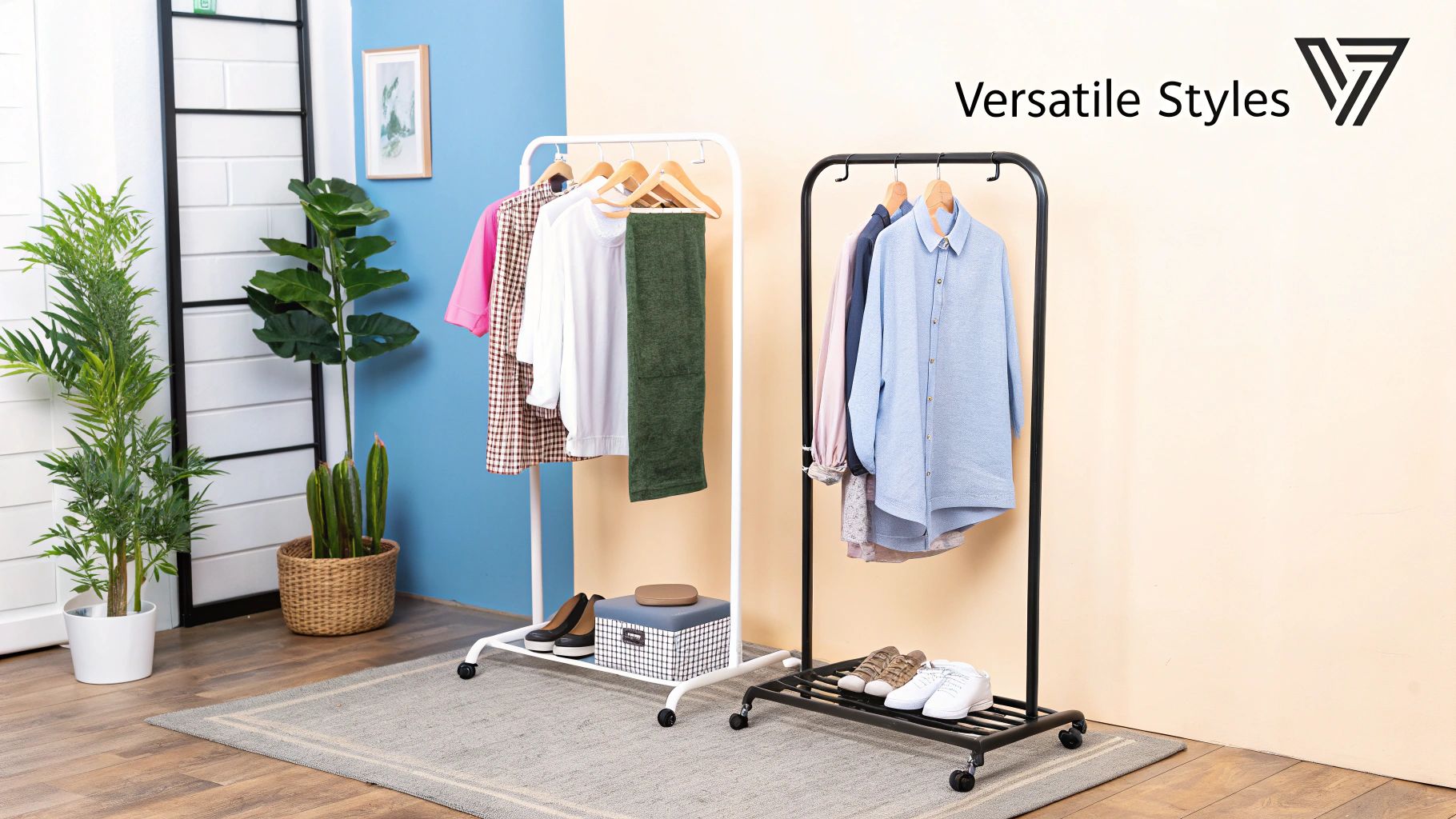 Trying to buy a portable clothing rack online can sometimes feel like a real gamble. You're hit with a wall of products that look the same, contradictory reviews, and descriptions promising unbelievable strength. To avoid that sinking feeling of buyer's remorse, you need to cut through the noise and find a rack that is genuinely strong and stable. Let’s break down what really separates a reliable workhorse from an expensive, wobbly mistake.
Trying to buy a portable clothing rack online can sometimes feel like a real gamble. You're hit with a wall of products that look the same, contradictory reviews, and descriptions promising unbelievable strength. To avoid that sinking feeling of buyer's remorse, you need to cut through the noise and find a rack that is genuinely strong and stable. Let’s break down what really separates a reliable workhorse from an expensive, wobbly mistake.
Interpreting Reviews and Red Flags
First off, you need to become a bit of a detective when it comes to customer reviews. A flood of five-star ratings, especially if they’re short and vague like "Great product!", can be a warning sign. What you're really looking for is detailed feedback from verified buyers who explain how they use the rack. They might share a specific win, like how it handled their entire winter coat collection, or a major fail, like a joint snapping during assembly. These real-world stories are pure gold.
Be on the lookout for these common red flags in product listings:
- Vague Material Descriptions: Phrases like "durable metal" don't mean much. A good manufacturer will tell you the type of steel or aluminium used and its thickness.
- No Mention of Warranty: A reputable brand will have confidence in its product. A minimum one-year warranty is a great indicator of quality and gives you some protection if things go wrong.
- Stock Photos Only: If a seller only uses generic, computer-generated images instead of photos of the actual product being used in a real setting, it's wise to be cautious.
Finding Genuine Value
Timing your purchase can also make a big difference to your wallet. While the big sales events are an obvious time to look, keep an eye out for discounts around late summer. This is when students are preparing for university, and retailers are competing for their business. A bit of strategic shopping can land you a higher-quality rack without breaking the bank. For anyone managing a complex wardrobe or styling specific outfits, getting the dimensions right is key. Our guide on how to take body measurements for clothes can help ensure every garment hangs just right.
Ultimately, putting a little more money into a well-reviewed, sturdily built portable clothing rack from a trusted retailer is the most sensible approach. It helps you avoid the false economy of buying a cheap rack that you'll just have to replace in a year. This is something more and more people are realising, as effective storage becomes more important, particularly in cities with smaller homes. In fact, the global market for these racks was valued at around US$ 2.97 billion in 2025 and is set to grow. You can learn more about the growth of the drying and clothing rack market from Persistence Market Research. By shopping smart, you're not just buying a rack—you're investing in organisation and your own peace of mind.
Assembly Mastery For Rock-Solid Results
So, you’ve picked out the perfect **portable clothing rack**, but getting it out of the box is only half the battle. Even the sturdiest steel frame can end up as a wobbly, frustrating mess if it’s not put together correctly. We've all been there, squinting at those tiny instruction diagrams that seem to miss the small details that actually make a difference, leaving you with a rack that leans or feels insecure. Drawing from some hard-won wisdom, a few simple tricks can ensure your rack is solid from the get-go.The Foundation of Stability
First things first, find a flat, level surface and lay out all your components. It might sound basic, but trying to build on an uneven floor can throw off the entire structure's alignment, leading to a permanent wobble you can't fix later. Before you even think about grabbing a screw, give everything a quick once-over. Make sure the vertical poles are perfectly straight and the base pieces sit completely flush with the floor.
Here’s a crucial tip that makes a world of difference: only partially tighten the bolts and screws during the initial assembly. Connect everything loosely first, which gives you some wiggle room for minor adjustments. Once the frame is fully constructed, stand it up where you plan to use it. Place a small amount of weight on the top rail—a few heavy books will do the trick. This helps the frame settle naturally into its final, load-bearing position.
Now, you can go back and systematically tighten every single connection. Work in a cross pattern (like you would when changing a car tyre) to distribute the tension evenly across the frame. This simple technique prevents one side from being pulled out of alignment and is key to achieving that rock-solid feel.
Beyond the Instruction Manual
There are a couple of things the instruction booklet will never tell you. For one, temperature can actually affect metal parts. If you're assembling a steel rack in a very cold room, the connections might feel tighter than they really are. As the metal warms up and expands, those joints can loosen. Putting your rack together at a moderate room temperature will give you the most accurate and lasting fit.
Finally, while most kits come with a tiny Allen key or a flimsy wrench, using your own tools will make your life so much easier. A good quality screwdriver or a ratchet with the correct bit offers far better leverage. This means you can secure the bolts much more effectively than you ever could with the small tool provided. Spending an extra five minutes to find the right tool can save you from future headaches and give your portable clothing rack the professional-grade stability it was designed for.
Maximising Every Inch Of Your Portable Clothing Rack
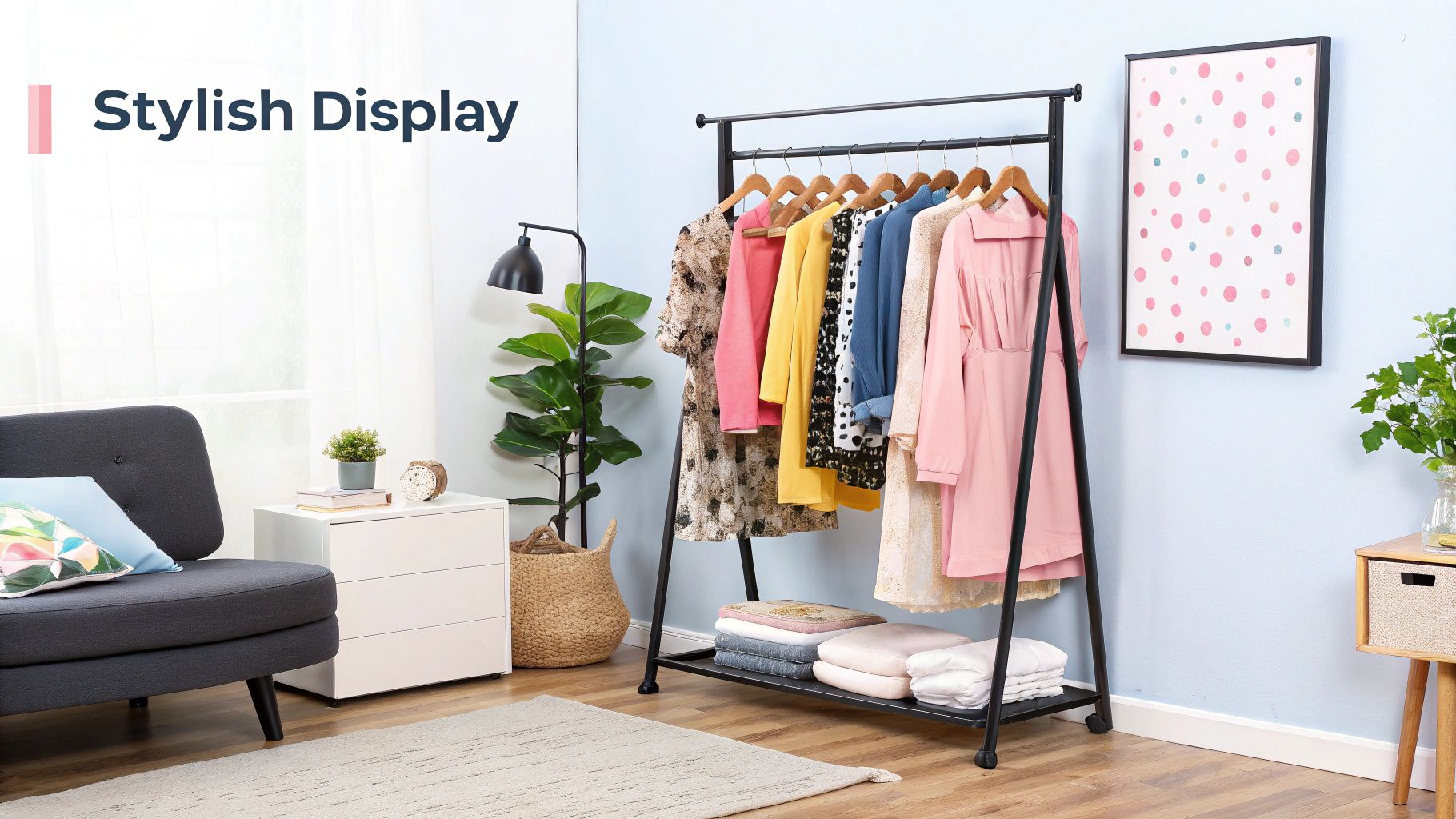
Once your portable clothing rack is assembled, it's tempting to just start hanging things. But to get the most out of it, a little strategy goes a long way. The real key to preventing a wobbly, sagging rail and making your rack last is smart weight distribution. A common misstep is piling all the heavy items—like winter coats and denim—at one end. This creates a single stress point that can cause the rail to bend over time.
Think like a shop merchandiser and balance the load. By alternating your heavier pieces with lighter ones, you spread the weight evenly across the entire length of the rail. It’s a simple trick that makes a huge difference to the rack's stability and lifespan.
Going Beyond Basic Hanging
To really make your rack work for you, think vertically and accessorise. Many of us forget about the valuable real estate at the base of the rack. It's the perfect spot for shoe trays or storage boxes to hold folded jumpers, accessories, or out-of-season items. Another easy win is switching to slim, non-slip velvet hangers. Compared to bulky wooden ones, they can increase your hanging space by up to 25%, letting you fit more on without it looking cluttered.
A seasonal rotation system is another game-changer, especially if you're tight on wardrobe space. Here’s how you can make it work:
- Zone It Out: Keep your current season’s most-worn items on one side of the rack for quick and easy access on busy mornings.
- Bag It Up: Store off-season clothes in breathable garment bags at the other end. This keeps them protected from dust but still within reach when the weather turns.
- Divide and Conquer: Simple rail dividers, just like the ones you see in shops, can help you categorise your clothes by type (trousers, tops, dresses) or even by complete outfit.
To help you visualise how to best set up your rack based on your space, we've put together a handy table with some practical ideas.
Clothing Organisation Strategies by Space Type
Practical organisation approaches for different living situations and space constraints
| Space Type | Organisation Strategy | Capacity Tips | Style Considerations |
|---|---|---|---|
| Small Flat/Studio | Use the rack for a "capsule wardrobe" of essentials. Rotate seasonally to keep it manageable. | Slimline hangers are a must. Utilise the base with stackable boxes for shoes and folded items. | Choose a rack that complements your decor (e.g., minimalist black metal or industrial-style pipes). |
| Guest Room | Keep the rack ready for visitors with a curated selection of essentials and plenty of empty hangers. | Use garment bags to protect a set of guest towels and bedding, stored at one end. | A simple, sturdy rack is ideal. Add a small basket on the base with toiletries for a hotel-like touch. |
| Pop-Up Shop/Market Stall | Organise by collection, colour, or size using rail dividers for a professional look. | A heavy-duty garment rail is essential to handle more stock and customer interaction. | The rack is part of your brand. Ensure it's clean, stable, and reflects your shop's aesthetic. |
| Shared House | Use as an overflow wardrobe for your room, organised by clothing type (workwear, casual, evening). | Labelled storage boxes at the base help keep personal items separate and tidy. | Look for a rack with adjustable height to fit under eaves or in awkward spaces. |
This table shows how a portable rack can be adapted to fit almost any need, from creating a mini-wardrobe in a tight space to setting up a professional retail display.
The Capsule Wardrobe Strategy
A portable clothing rack is the perfect tool for building and managing a capsule wardrobe. Take sewing enthusiast Michelle, who used a rack to plan a complete travel wardrobe from scratch. Having a dedicated space to see how each handmade piece worked with others was crucial. Her rack allowed her to visualise her entire collection, making it easy to spot gaps and identify versatile items, like a pair of olive slacks that matched nearly every top.
This turns your rack from just storage into an active styling station. It’s an essential approach for anyone running a small boutique or selling at a market. A well-organised rail doesn't just look more professional; it helps customers imagine potential outfits, encouraging them to buy. By thinking about organisation, you can transform your portable rack into a truly efficient, multi-purpose system that makes the most of every inch.
Solving Problems Before They Drive You Crazy
We’ve all been there. Your portable clothing rack has been a trusty workhorse for months, and then one day, it starts to wobble ominously. Or perhaps a wheel jams right when you're trying to move it across the room. These little frustrations can be maddening, but most of them have surprisingly simple fixes if you know what you’re looking for. Before you write it off as a lost cause, a quick bit of detective work can often solve the problem and save you the hassle and cost of a replacement.
Diagnosing Common Issues
The most common complaint I hear is about a wobbly rack. Before you start questioning its quality, the first thing to check is how you've loaded it. Uneven weight distribution is the number one culprit. If you’ve piled all your heavy winter coats on one end, you're putting a huge amount of stress on a single point, which will naturally cause the frame to lean. Try reorganising your clothes, spreading the heavy items out evenly across the rail. If it’s still not stable, grab a screwdriver or Allen key and retighten all the connections. Work in a criss-cross pattern, like you would when changing a car tyre, to ensure you're applying even pressure. You'd be surprised how often a single loose screw is the source of the instability.
Another classic headache is with the castors, or wheels. When a wheel gets stuck or refuses to roll smoothly, the problem is almost always debris. Hair, threads, and bits of carpet are brilliant at getting tangled around the axle, eventually bringing it to a grinding halt.
- The Quick Fix: Gently tip the rack on its side and use a pair of tweezers or small pliers to pull out any gunk that's wound itself around the wheel's axle. A quick spritz of silicone lubricant afterwards can make it feel brand new.
- A Bit of Prevention: Get into the habit of checking the wheels every month or so, especially if you move the rack between different types of flooring. This five-minute check can prevent a major jam later on.
Knowing When to Repair vs. Replace
So, when is a problem a simple fix, and when is it a sign of something more serious? A slight wobble from an overloaded rack or a sticky wheel are things you can almost always sort out yourself. If the main frame is still straight and the joints are sound, you should definitely try a repair. Think of these little jobs as routine maintenance.
However, some issues are red flags signalling that it’s time for an upgrade. If the metal tubing itself is bent out of shape, a welded joint has cracked, or a plastic connector has completely snapped, a simple repair isn't going to cut it. These are signs of a structural failure. Trying to patch up a critically damaged frame is a temporary fix at best and a potential safety hazard at worst. In this situation, it’s far more sensible to invest in a new, more robust portable clothing rack that’s built to handle what you need it for.
Getting Long-Term Value From Your Investment
Your portable clothing rack isn't just a temporary fix; it should be a reliable part of your home or business for years to come. Ensuring it lasts is all about simple, consistent habits rather than major overhauls. Think of it less like a piece of static furniture and more like a functional tool that needs a bit of attention to perform at its best. By adopting a few key practices, you can seriously extend its life and get genuine value from your purchase.
Creating a Realistic Maintenance Routine
Long-term care starts with a simple maintenance schedule you can actually stick to. Forget complicated checklists and focus on two key areas. First, make a habit of checking the wheels every month or so. Just tip the rack gently on its side and clear away any hair, thread, or fluff that has become tangled around the axles. This five-minute job prevents those annoying jams and scrapes that can damage your floors.
Second, every few months, grab your screwdriver or Allen key and give all the joints and connections a quick tighten. Screws can loosen over time, especially if you move the rack around a lot, and this is often the root cause of that dreaded wobble. This simple act reinforces the frame's structural integrity, keeping it stable and secure. Just like tuning an instrument, these small adjustments ensure your rack continues to perform perfectly.
Smart Storage and Knowing When to Upgrade
There will be times when you need to store your rack away. To avoid damage, it’s best to disassemble it partially. Don't just fold it and lean it against a wall where it can be knocked over. Loosen the main connections, collapse it down, and store the components together in a dry place. This prevents stress on the joints and protects it from accidental bumps.
Eventually, your needs might change. So, how do you know if you need an upgrade versus a simple adjustment? If you consistently find yourself overloading the rail, or if your collection of heavy winter coats now rivals a small shop's inventory, your needs have probably outgrown your current setup. For those whose clothing collections have become more curated, like a dedicated set of tailored pieces, you might want to showcase them more effectively. Pairing your rack with other display tools, such as the elegant Display Guru female dressmakers dummy, can create a more professional and organised space.
A structural failure, like a bent pole or a cracked weld, is a clear sign it's time to invest in a sturdier model. By honestly assessing how you use it, you can make a smart decision that supports your lifestyle for years to come.
Ready to invest in a display solution that lasts? Explore the full range of durable garment rails and display tools at Display Guru today.


